Lf4TE
Page 124
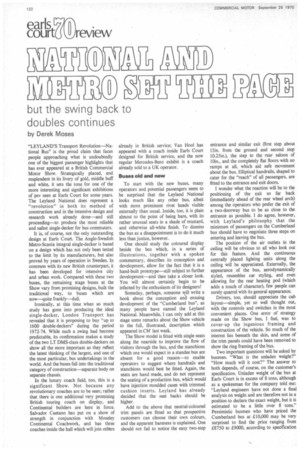
Page 125
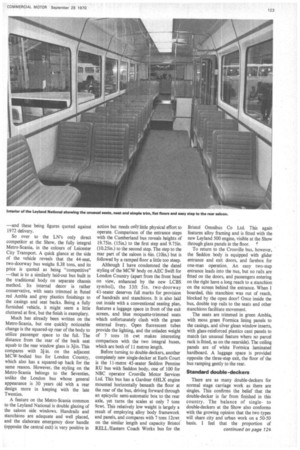
Page 126
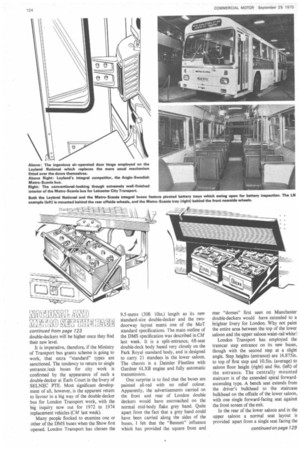
Page 131
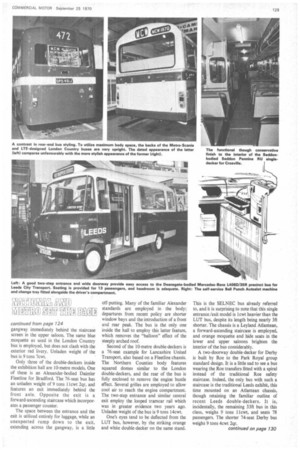
Page 132
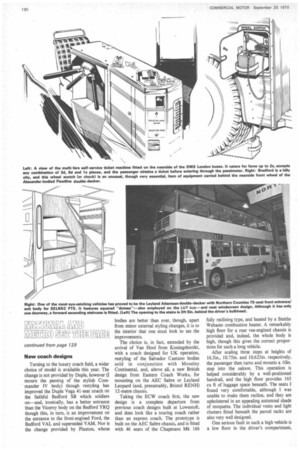
Page 133
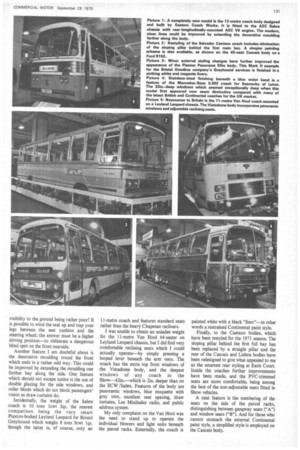
If you've noticed an error in this article please click here to report it so we can fix it.
but the swing back to doubles continues
by Derek Moses "LEYLAND'S Transport Revolution—National Bus" is the proud claim that faces people approaching what is undoubtedly one of the biggest passenger highlights that has ever appeared at a British Commercial Motor Show. Strategically placed, and resplendent in its livery of gold, middle buff and white, it sets the tone for one of the more interesting and significant exhibitions of psv seen at Earls Court for some years. The Leyland National does represent a "revolution" in both its method of construction and in the intensive design and research work already done—and still proceeding—to produce the most reliable and safest single-decker for bus commuters.
It is, of course, not the only outstanding design at Earls Court. The Anglo-Swedish Metro-Scania integral single-decker is based on a design which has not only been tested to the limit by its manufacturers, but also proved by years of operation in Sweden. In common with its new British counterpart, it has been developed for intensive city and urban work. Compared with these two buses, the remaining stage buses at the Show vary from promising designs, built the traditional way, to buses which are now—quite frankly—dull.
Ironically, at this time when so much study has gone into producing the ideal single-decker, London Transport has revealed that it is proposing to buy "up to 1600 double-deckers" during the period 1972-74. While such a swing had become predictable, its confirmation makes a study of the two LT DMS-class double-deckers on show all the more important as they reflect the latest thinking of the largest, and one of the most particular, bus undertakings in the world. And the buses fall into the traditional category of construction—separate body on separate chassis.
In the luxury coach field, too, this is a significant Show. Not because any revolutionary coaches are to be seen; rather that there is one additional very promising British touring coach on display, and Continental builders are here in force. Salvador Caetano has put on a show of strength in conjunction with Moseley Continental Coachwork, and has three coaches inside the hall which will join °titers already in British service; Van Hool has appeared with a coach inside Earls Court designed for British service, and the now regular Mercedes-Benz exhibit is a coach already sold to a UK operator.
Buses old and new To start with the new buses, many operators and potential passengers seem to be surprised that the Leyland National looks much like any other bus, albeit with more prominent rivet heads visible externally than usual. Inside, too, it is plain almost to the point of being bare, with its rather unusual seats in a shade of mustard, and otherwise all-white finish. To dismiss the bus as a disappointment is to do it much less than justice, however.
One should study the coloured display beside the bus which, in a series of illustrations, together with a spoken commentary, describes its conception and development, allow for the fact that it is a hand-built prototype—still subject to further development—and then take a closer look. You will almost certainly begin to be infected by the enthusiasm of its designers!
Someday, perhaps, someone vKill write a book about the conception and ensuing development of the "Cumberland bus", as many people have named the Leyland National, Meanwhile, I can only add at this stage some remarks about the Show vehicle to the full, illustrated, description which appeared in CM last week.
The Show model is fitted with single seats along the nearside to improve the flow of visitors through the bus, and the stanchions which one would expect in a standee bus are absent for a good reason—to enable operators to suggest where handrails and stanchions would best be fitted. Again, the seats are hand made, and do not represent the seating of a productiOn bus, which would have injection moulded cases with trimmed cushion inserts. Leyland has already decided that the seat backs should be higher.
Add to the above that neutral-coloured trim panels are fitted so that prospective customers can choose their own colours, and the apparent bareness is explained. One should not fail to notice the easy two-step entrance and similar exit (first step about 15in. from the ground and second step 10.25in.), the step to the rear saloon of 10in., and the completely flat floors with no ramps at all, which aid safe movement about the bus. Elliptical handrails, shaped to cater for the "reach" of all passengers, are fitted to the entrance and exit doors.
I wonder what the reaction will be to the positioning of the exit so far back (immediately ahead of the rear wheel arch) among the operators who prefer the exit of a two-doorway bus to be as close to the entrance as possible. I do agree, however, with Leyland's philosophy that the minimum of passengers on the Cumberland bus should have to negotiate three steps on entering and leaving the bus.
The position of the air outlets in the ceiling will be obvious to all who look out for this feature. And the continuous centrally placed lighting units along the ceiling will be appreciated. Externally, the appearance of the bus, aerodynamically styled, resembles car styling, and even allowing for the rear heating pod (which adds a touch of character), few people can surely quarrel with its general appearance.
Drivers, too, should appreciate the cab layout—simple, yet so well thought out, with the controls and switches in the most convenient places. One error of strategy made on the Show bus, I feel, was to cover-up the ingenious framing and construction of the vehicle. So much of the interest lies beneath the skin, and some of the trim panels could have been removed to show the ring framing of the bus.
Two important questions will be asked by busmen. "What is the unladen weight?" "How much will it cost?" The answer to both depends, of course, on the customer's specification. Unladen weight of the bus at Earls Court is in excess of 8 tons, although as a spokesman for the company told me: "Leyland engineers have not done a final analysis on weight and are therefore not in a position to declare the exact weight, but it is estimated to be a little over 8 tons." Pessimistic busmen who have priced the Cumberland bus at £10,000 may be very surprised to find the price ranging from £8750 to £9000, according to specification — and these being figures quoted against 1972 delivery.
So over to the LN's only direct competitor at the Show, the fully integral Metro-Scania. in the colours of Leicester City Transport. A quick glance at the side of the vehicle reveals that the 44-seat, two-doorway bus weighs 8.38 tons, and its price is quoted as being "competitive" — that is to a similarly laid-out bus built in the traditional body on separate chassis method. Its internal decor is rather conservative, with seats trimmed in fluted red Ambla and grey plastics finishings to the casings and seat backs. Being a fully furnished vehicle, it might seem a little cluttered at first, but the finish is exemplary.
Much has already been written on the Metro-Scania, but one quickly noticeable change is the squared-up rear of the body to utilize passenger space to the full. The distance from the rear of the back seat squab to the rear window glass is nin. This compares with in. on the adjacent MCW-bodied bus for London Country, which also has a squared-up back for the same reason. However, the styling on the Metro-Scania belongs to the Seventies, unlike the London bus whose general appearance is 30 years old with a rear design more in keeping with the late Twenties.
A feature on the Metro-Scania common to the Leyland National is double glazing of the saloon side windows. Handrails and stanchions are adequate and well placed, and the elaborate emergency door handle (opposite the central exit) is very positive in action but needs only little physical effort to operate. Comparison of the entrance steps with the Cumberland bus reveals heights of 19.75in. (15in.) to the first step and 9.75in. (10.25in.) to the second step. The step to the rear part of the saloon is 6in. (10in.) but is followed by a ramped floor a little too steep.
Although I have condemned the dated styling of the MCW body on AEC Swift for London Country (apart from the front head on view, enhanced by the new LCBS symbol), the 33ft Sin, two-doorway 41-seater deserves full marks for provision of handrails and stanchions. It is also laid out inside with a conventional seating plan, features a luggage space in front of the exit screen, and blue moquette-trimmed seats which unfortunately clash with the green external livery. Open fluorescent tubes provide the lighting, and the unladen weight of 7 tons 16 cwt makes interesting comparison with the two integral buses, which are both of 11 metres length.
Before turning to double-deckers, another completely new single-decker at Earls Court is the 11-metre 45-seater Seddon Pennine RU bus with Seddon body, one of 100 for NBC operator Crosville Motor Services Ltd. This bus has a Gardner 6HLX engine mounted horizontally beneath the floor at the rear of the bus, driving forward through an epicyclic semi-automatic box to the rear axle, yet turns the scales at only 7 tons 9cwt. This relatively low weight is largely a result of employing alloy body framework and panels, and compares with 7 tons 12cwt on the similar length and capacity Bristol RELL /Eastern Coach Works bus for the Bristol Omnibus Co Ltd. This again features alloy framing and is fitted with the new Leyland 500 engine, visible at the Show through glass panels in the floor. '
To return to the Crosville bus, however, the Seddon body is equipped with glider entrance and exit doors, and farebox for one-man operation. An easy two-step entrance leads into the bus, but no rails are fitted on the doors, and passengers entering on the right have a long reach to a stanchion on the screen behind the entrance. When I boarded, this stanchion was out of reach, blocked by the open door! Once inside the bus, double top rails to the seats and other stanchions facilitate movement.
The seats are trimmed in green Ambla, with moss green Formica lining panels to the casings, and silver glean window inserts, with glass-reinforced plastics cant panels to match (an unusual feature where no parcel rack is fitted, as on the nearside). The ceiling panels are of white Formica laminated hardboard. A luggage space is provided opposite the three-step exit, the floor of the bus ramping gently to the rear.
Standard double–deckers
There are as many double-deckers for normal stage carriage work as there are singles. This confirms the belief that the double-decker is far from finished in this country. The balance of singleto double-deckers at the Show also conforms with the growing opinion that the two types will share city and urban work on a 50-50 basis. I feel that the proportion of double-deckers will be higher once they find their new level.
It is imperative, therefore, if the Ministry of Transport bus grants scheme is going to work, that extra "standard" types are sanctioned. The tendency to return to single entrance /exit buses for city work is confirmed by the appearance of such a double-decker at Earls Court in the livery of SELNEC PTE. Most significant development of all, however, is the apparent return to favour in a big way of the double-decker bus for London Transport work, with the big inquiry now out for 1972 to 1974 replacement vehicles (CM last week).
Many people flocked to examine one or other of the DMS buses when the Show first opened. London Transport has chosen the
9.5-metre (30ft 10in.) length as its new standard-size double-decker and the twodoorway layout meets one of the MoT standard specifications. The main outline of the DMS specification was described in CM last week. It is a split-entrance, 68-seat double-deck body based very closely on the Park Royal standard body, and is designed to carry 21 standees in the lower saloon. The chassis is a Daimler Fleetline with Gardner 6LXB engine and fully automatic transmission.
One surprise is to find that the buses are painted all-red with no relief colour. Apparently, the advertisements carried on the front and rear of London double deckers would have encroached on the normal mid-body flake grey band. Quite apart from the fact that a grey band could have been carried along the sides of the buses, 1 felt that the "Bennett" influence which has provided the square front and rear "domes" first seen on Manchester double-deckers would have extended to a brighter livery for London. Why not paint the entire area between the top of the lower saloon and the upper saloon waist-rail white': London Transport has employed the tramcar step entrance on its new buses, though with the second step at a slight angle. Step heights (entrance) are 16.875in. to top of first step and 10.5in. (average) to saloon floor height (right) and 9in. (left) of the entrance. The centrally mounted staircase is of the extended spiral forwardascending type. A bench seat extends from the driver's bulkhead to the staircase bulkhead on the offside of the lower saloon, with one single forward-facing seat against the front screen of the exit.
In the rear of the lower saloon and in the upper saloon a normal seat layout is provided apart from a single seat facing the gangway immediately behind the staircase screen in the upper saloon. The same blue moquette as used in the London Country bus is employed. but does not clash with the exterior red livery. Unladen weight of the bus is 9 tons 7cwt.
Only three of the double-deckers inside the exhibition hall are 10-metre models. One of these is an Alexander-bodied Daimler Fleetline for Bradford. The 76-seat bus has an unladen weight of 9 tons 1 lcwt 2qr, and features an exit immediately behind the front axle. Opposite the exit is a forward-ascending staircase which incorporates a passenger counter.
The space between the entrance and the exit is utilized entirely for luggage, while an unexpected ramp down to the exit, extending across the gangway, is a little off-putting. Many of the familiar Alexander standards are employed in the body; departures from recent policy are shorter window bays and the introduction of a front and rear peak. The bus is the only one inside the hall to employ this latter feature, which removes the "balloon" effect of the steeply arched roof.
Second of the 10-metre double-deckers is a 76-seat example for Lancashire United Transport, also based on a Fleetline chassis. The Northern Counties body features squared domes similar to the London double-deckers, and the rear of the bus is fully enclosed to remove the engine bustle effect. Several grilles are employed to allow cool air to reach the engine compartment. The two-step entrance and similar central exit employ the looped tramcar rail which was in greater evidence two years ago. Unladen weight of the bus is 9 tons I4cwt.
One's eyes tend to be deflected from the LUT bus, however, by the striking orange and white double-decker on the same stand. This is the SELNEC bus already referred to, and it is surprising to note that this single entrance/exit model is lcwt heavier than the LUT bus, despite its length being nearly 3ft shorter. The chassis is a Leyland Atlantaan, a forward-ascending staircase is employed, and orange moquette and hide seats in the lower and upper saloons brighten the interior of the bus considerably.
A two-doorway double-decker for Derby is built by Roe to the Park Royal group standard design. It is a little sad to see a bus wearing the Roe transfers fitted with a spiral instead of the traditional Roe safety staircase. Indeed, the only bus with such a staircase is the traditional Leeds exhibit, this time mounted on an Atlantean chassis, though retaining the familiar outline of recent Leeds double-deckers. It is, incidentally, the remaining 33ft bus in this class, weighs 9 tons 1 lcwt, and seats 78 passengers. The shorter 74-seat Derby bus weighs 9 tons 4cwt 2qr. New coach designs Turning to the luxury coach field, a wider choice of model is available this year. The change is not provided by Duple, however (I mourn the passing of the stylish Commander IV body) though restyling has improved the Duple Vega 41-seat coach on the faithful Bedford SB which soldiers on—and, ironically, has a better entrance than the Viceroy body on the Bedford YRQ though this, in turn, is an improvement on the entrance to the front-engined Ford, the Bedford VAL and superseded VAM. Nor is the change provided by Pluton, whose bodies are better than ever, though. apart from minor external styling changes, it is to the interior that one must look to see the improvements.
The choice is, in fact, extended by the arrival of Van Hool from Koningshooikt, with a coach designed for UK operation, restyling of the Salvador Caetano bodies sold in conjunction with Moseley Continental, and, above all, a new British design from Eastern Coach Works, for mounting on the AEC Sabre or Leyland Leopard (and, presumably, Bristol RENH) 12-metre chassis.
Taking the ECW coach first, the new design is a complete departure from previous coach designs built at Lowestoft, and does look like a touring coach rather than an express coach. The prototype is built on the AEC Sabre chassis, and is fitted with 46 seats of the Chapmans Mk 166 fully reclining type. and heated by a Smiths Webasto combustion heater. A remarkably high floor for a rear vee-engined chassis is provided and, indeed, the whole body is high, though this gives the correct proportions for such a long vehicle.
After scaling three steps at heights of 16.5in., 10.75in. and 10.625in. respectively, the passenger then turns and mounts a 10in. step into the saloon. This operation is helped considerably by a well-positioned handrail, and the high floor provides 165 cu ft of luggage space beneath. The seats I found very comfortable, although I was unable to make them recline, and they are upholstered in an appealing autumnal shade of moquette. The individual vents and light clusters fitted beneath the parcel racks are also very well designed.
One serious fault in such a high vehicle is a low floor in the driver's compartment, visibility to the ground being rather poor! It is possible to wind the seat up and trap your legs between the seat cushion and the steering wheel; the answer must be a higher driving position—to obliterate a dangerous blind spot on the front nearside.
Another feature I am doubtful about is the decorative moulding round the front which ends in a rather odd way. This could be improved by extending the moulding one further bay along the side. One feature which should not escape notice is the use of double glazing for the side windows, and roller blinds which do not block passengers' vision as draw curtains do.
Incidentally, the weight of the Sabre coach is 10 tons lcwt 3qr, the nearest comparison being the very smart Plaxton-bodied Leyland Leopard for Bristol Greyhound which weighs 8 tons 9cwt lqr, though the latter is, of course, only an 11-metre coach and features standard seats rather than the heavy Chapman recliners.
I was unable to obtain an unladen weight for the 11-metre Van Hool 44-seater on Leyland Leopard chassis, but I did find very comfortable reclining seats which I could actually operate—by simply pressing a looped lever beneath the arm rests. The coach has the extra top front windows of the Vistadome body, and the deepest windows of any coach in the Show-42in.—which is 2in. deeper than on the ECW /Sattre. Features of the body are panoramic windows, blue moquette with grey trim, excellent seat spacing, draw curtains, Lee Minihailer radio, and public address system.
My only complaint on the Van Hool was the need to stand up to operate the individual blowers and light units beneath the parcel racks. Externally, the coach is painted white with a black "llmo"—in other words a restrained Continental paint style.
Finally, to the Caetano bodies, which have been restyled for the 1971 season. The sloping pillar behind the first full bay has been replaced by a straight pillar and the rear of the Cascais and Lisboa bodies have been redesigned to give what appealed to me as the smartest rear styling at Earls Court. Inside the coaches further improvements have been made, and the PVC-trimmed seats are more comfortable, being among the best of the non-adjustable seats fitted in Show vehicles.
A neat feature is the numbering of the seats on the side of the parcel racks, distinguishing between gangway seats ("A") and window seats ("B").And for those who cannot stomach the external Continental paint style, a simplified style is employed on the Cascais body.


























































































































































































